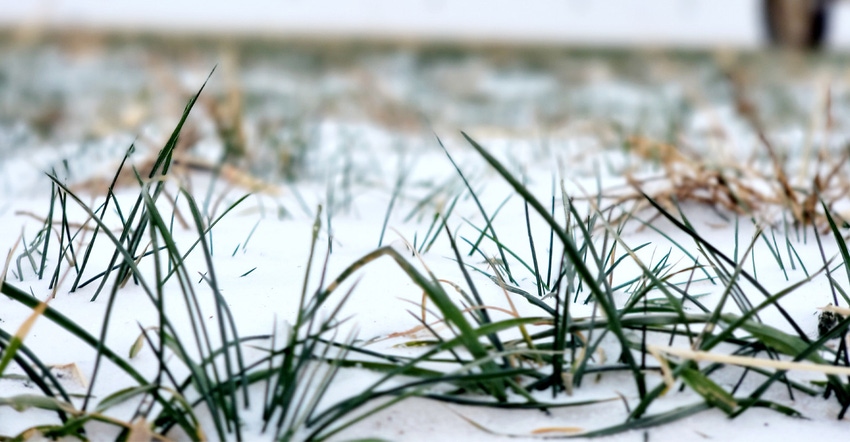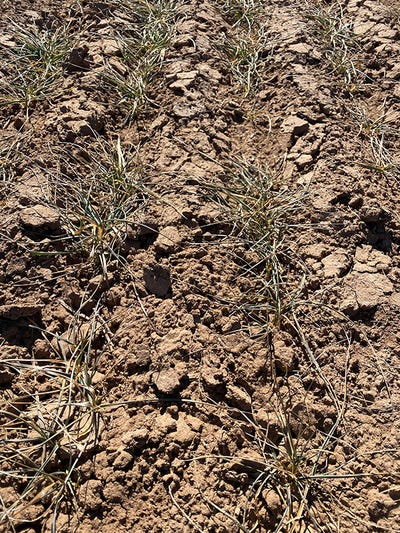
A combination of persistent drought and bitter cold have taken a toll on Southwest wheat prospects.
The Feb. 6 USDA National Agricultural Statistics Service (NASS) reports show more than 70% of the Texas crop in poor or very poor condition.
 Dryland wheat nursery at Bushland reflecting wind damage. (Photos by Jourdan Bell, Texas AgriLife)
Dryland wheat nursery at Bushland reflecting wind damage. (Photos by Jourdan Bell, Texas AgriLife)
In Oklahoma, the Jan. 23 report indicates more than 40% of the state’s wheat crop in poor or very poor conditions with only 15% listed as good.
Most of Texas’ wheat production area shows short to very short moisture ratings exceeding 50%.
Oklahoma topsoil moisture ratings listed 48% very short and 33% short. Only 19% was rated adequate. Also, 37% of Oklahoma subsoil was rated very short with 39% listed as short. Only 24% was adequate.
Drought and cold
Conditions across the Texas High Plains range from “holding on” to “non-existent,” according to Texas A&M AgriLife Agronomist Jourdan Bell, Amarillo.
See, Funds available to border producers for infrastructure repairs
“I have been in several fields this week,” Bell says. “Dryland fields are bad to non-existent. In most cases, the dryland fields were dusted in, and did not receive enough rain for stand establishment.
“Producers had a brief, decent planting window in September to October. If wheat was planted during or before this period, there was establishment, and a few of those fields are still holding on, but some of these fields did not tiller, so yield potentials are very low. I doubt we will see much spring tillering unless it starts raining. I anticipate we will start to see more stress and ensuing yield losses as conditions warm.”
See, Texas Ag Forum to highlight carbon credits, climate initiatives
Jourdan visited fields in the Northeast Texas Panhandle between Dalhart and Hartley Feb. 9. “I saw leaf burn in all northeast fields, even irrigated." Snowfall received at the beginning of February was very dry, "so there was neither beneficial moisture nor coverage from the snow with the zero-degree temperatures,” she says.
 Severely drought stressed wheat with leaf burn.
Severely drought stressed wheat with leaf burn.
“Water stress is very evident in irrigated fields since pivots have been off since late November. Many dryland fields in the western Panhandle and eastern New Mexico have blown out. Cattle are already being pulled off wheat pasture due to limited forage. With forage and silage deficits in the dairies, I think we may lose quite a bit of the viable grain acres to silage.”
Oklahoma
The NAAS report for Oklahoma shows less than one-half inch of rainfall in the month of January, with the Southeast district recording the highest precipitation at 1.28 inches and the Panhandle and North Central districts recording the lowest precipitation at 0.10 of an inch. The report noted the January 18th US Drought Monitor Report showing 95% of the state abnormally dry to exceptional drought, up 63 points from the previous year.
Also, 88% of the state was in the moderate drought to exceptional drought category, up 76% from the previous year.
Statewide temperatures averaged in the mid to low 30s, with the lowest recording of minus 5 degrees at Kenton on Sunday, January 2, and the highest recording of 78 degrees at Waurika on Tuesday, January 18. Topsoil and subsoil moisture conditions were rated mostly short to adequate.
About the Author(s)
You May Also Like






